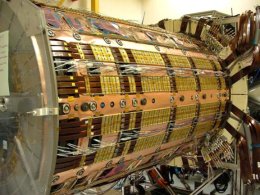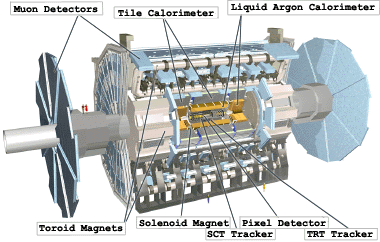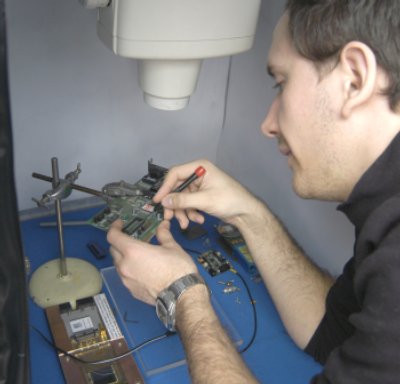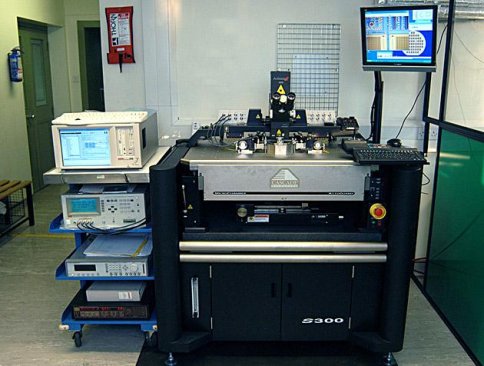Summer Student Projects 2011
 The following list will give some idea of the range and diversity of previous Summer Studentship Scheme projects, along with the named individuals who participated.
The following list will give some idea of the range and diversity of previous Summer Studentship Scheme projects, along with the named individuals who participated.
Silicon Pixel detectors for high luminosity upgrades of the LHC
 The ATLAS pixel detector system will be upgraded in several stages over the next 10 years to allow the ATLAS experiment to take full advantage of the present LHC and the planned upgrades to the LHC (known as the super LHC). One of the consequences of the pixel system upgrades will be an increase in the radiation exposure of the sensors from the expected exposure of 1E15 1MeV equivalent neutrons per cm2 by a factor of 10 (for convenience particle radiation dose is normalized to the energy loss from 1MeV neutrons). Both the electronics and the sensors will have to survive this fluence.
The ATLAS pixel detector system will be upgraded in several stages over the next 10 years to allow the ATLAS experiment to take full advantage of the present LHC and the planned upgrades to the LHC (known as the super LHC). One of the consequences of the pixel system upgrades will be an increase in the radiation exposure of the sensors from the expected exposure of 1E15 1MeV equivalent neutrons per cm2 by a factor of 10 (for convenience particle radiation dose is normalized to the energy loss from 1MeV neutrons). Both the electronics and the sensors will have to survive this fluence.
To this end ATLAS research and development projects on radiation hard pixel sensor technologies are currently examining different sensor technologies. The electronics to cope with the expected radiation fluence has been developed.
This project will study the electrical and charge collection characteristics of silicon sensors connected to ATLAS pixel electronics after a radiation fluence applicable to the ATLAS pixel upgrade scenarios. A strontium-90 electron source will be used as a source of high energy electrons to deposit charge in the silicon detector in the same fashion as in the operational experiment. The response of different detector technologies (3D and planar silicon sensors) as a function of detector bias, operational temperature, and temperature history will be made.
Student: Jessica Turner, P3
Supervisor: Richard Bates
Duration 6 weeks
Grid User Interface
 Grid computing is a powerful tool that enables physicists to handle the large volumes of compute and data that is generated by modern, high resolution instruments. There are several systems used for building such Grids; two of the dominant technologies used in Europe are the gLite stack, and the ARC system. Both of these systems have their own powerful yet unique interface methods. Neither of these is similar to the more conventional batch system interface, the IEEE standard 1003.1.
Grid computing is a powerful tool that enables physicists to handle the large volumes of compute and data that is generated by modern, high resolution instruments. There are several systems used for building such Grids; two of the dominant technologies used in Europe are the gLite stack, and the ARC system. Both of these systems have their own powerful yet unique interface methods. Neither of these is similar to the more conventional batch system interface, the IEEE standard 1003.1.
It has been demonstrated that the iEEE qsub interface contains all of the features needed to express a Grid computation. A set of interface programs has been written to accept qsub scripts and submit them to the gLite stack. This project would involve extending this work in order to be able to submit to ARC as well. Successful completion of the project will result in a useful tool, with users ready to use it, and possibly presentation at a technical conference.
Ability to programme is essential for this project; although not the most complicated of compilers, some familiarity with complier theory will be useful. The existing code is written in Python; and produces an intermediate representation of the user's script, then writes out the gLite Job Description Language. It is expected that the intermediate representation would require small extensions in order to fully support ARC as well as gLite, with the bulk of the work being in writing the suitable output module.
http://www.nordugrid.org/arc/
Student: Michal Wysokinski, 4th year, Cracow, Poland
Supervisor: Stuart Purdie
Duration: 6 weeks
Top Quark Physics at ATLAS
 The Glasgow ATLAS group is involved in studies of top physics using the ATLAS detector at the LHC. The LHC produces top quarks at a very large rate, making it an ideal place to study the top quark's properties.
The Glasgow ATLAS group is involved in studies of top physics using the ATLAS detector at the LHC. The LHC produces top quarks at a very large rate, making it an ideal place to study the top quark's properties.
This project will aim to study production and properties of the top quark, using real ATLAS data.
Student: Paul Mullen, P4
Supervisor: James Ferrando
Duration: 6 weeks
Characterisation of CdTe hybrid pixel detector TimePix
 Hybrid pixel detectors have found applications in many areas of science. Having the option of various detection media with multi-pixel readout electronics makes the technology suitable for studying the intrinsic properties of exotic materials such as CdTe. Small pixels allow detailed study of inherent non-uniformities in the material such as grain boundaries and Te precipitates.
Hybrid pixel detectors have found applications in many areas of science. Having the option of various detection media with multi-pixel readout electronics makes the technology suitable for studying the intrinsic properties of exotic materials such as CdTe. Small pixels allow detailed study of inherent non-uniformities in the material such as grain boundaries and Te precipitates.
You will take part in characterisation of CdTe Timepix assembly for imaging and spectroscopic applications using modern equipment and radioactive sources. Data will be collected using PixelMan program for the Medipix family of detectors. The analysis will be accomplished in ROOT or Matlab.
You are expected to have some understating of semiconductor detectors. Preference will be given to candidates with knowledge of C++ or Matlab.
Student: Vytautas Astromskas, P3
Supervisor: Dima Maneuski
Duration: 6 weeks
Medipix in Museums
 Take a wander though an art gallery, such as The Hunterian Museum here at Glasgow University, and you will be surrounded by images created by artists ranging over 100's of years, and over countless subjects, all a product of the imagination and skill of the painter. However, many more images are present than apparent to the naked eye. Behind the visible layer in a great number of the paintings you see, there exists "hidden" images. Due to the expense involved it was common practice among artists to recycle a canvas and earlier versions of the finished work, or perhaps completely different scenes or subjects, wait to be revealed. Unveiling these images and the remarkable insight they give is of keen interest to art lovers and is critical to the work of art historians.
Take a wander though an art gallery, such as The Hunterian Museum here at Glasgow University, and you will be surrounded by images created by artists ranging over 100's of years, and over countless subjects, all a product of the imagination and skill of the painter. However, many more images are present than apparent to the naked eye. Behind the visible layer in a great number of the paintings you see, there exists "hidden" images. Due to the expense involved it was common practice among artists to recycle a canvas and earlier versions of the finished work, or perhaps completely different scenes or subjects, wait to be revealed. Unveiling these images and the remarkable insight they give is of keen interest to art lovers and is critical to the work of art historians.
This project proposes to uses the most advanced X-ray detection chips in the world, the Medipix/TimePix chip family to design a table top experiment to provide X-ray transmission imaging of paintings provided by the Department of Art History and the Hunterian Museum. The student will be required to set-up a scanning system which will allow X-ray transmission and fluorescence imaging of these images concealed behind the picture.
Student: Isla McCulloch, P2
Supervisor: Aaron Mac Raighne
Duration: 6 weeks
Prize international Internships in Science and Engineering
Title of Project: Characterising Gated Lateral Photodiodes for use in Detecting Charged Particles and Ionising Radiation
This project aims to investigate the response of a new type of silicon-based radiation detector to ionising radiation and charged particles. The new detector has been demonstrated recently and features the ability to change its relative sensitivity to different wavelengths (colours) of light by changing the voltage applied to a pair of gate electrodes at the top of the device. This is an entirely new capability for radiation detectors. While the detector has been sufficiently characterised with infrared radiation and visible light its potential for detecting high energy radiation i.e. ultraviolet and X-ray radiations as well as energetic particle flux, has not been explored. In the proposed project the student will attempt to do that by preparing devices for measurement in the school of Electronics and Electrical Engineering and then carrying out the measurements with the school of Physics and Astronomy.
Applicants’ Names and Schools:
Dr Faiz Rahman, Engineering
Dr Chris Parkes, Physics and Astronomy
Funding duration: 10-week project

